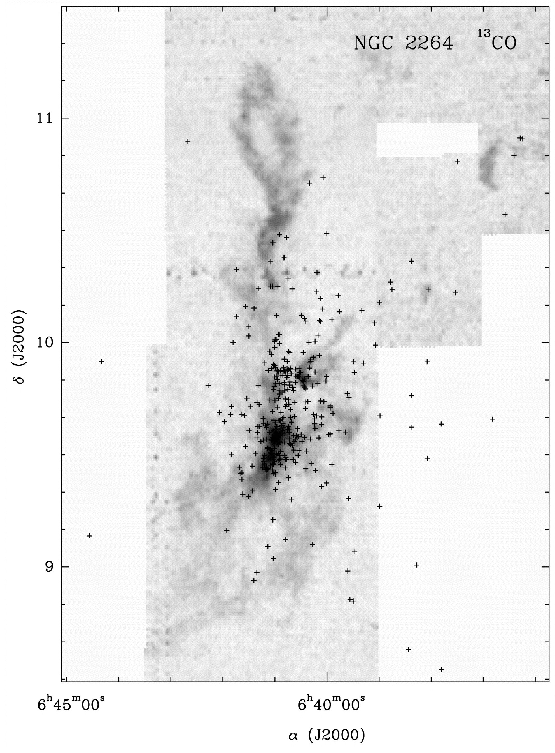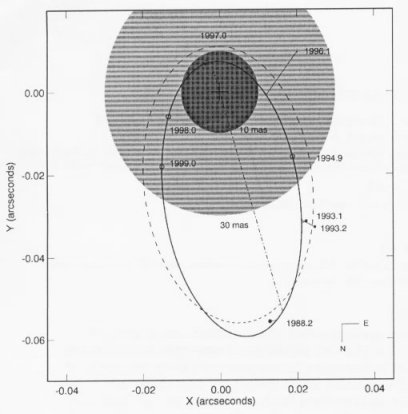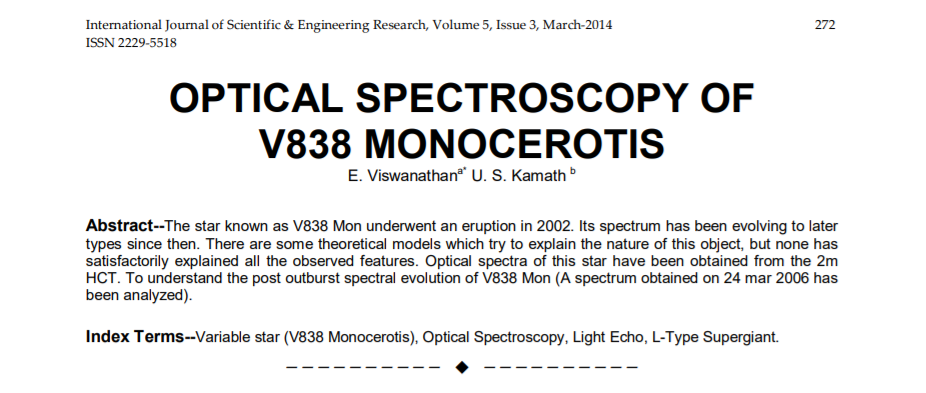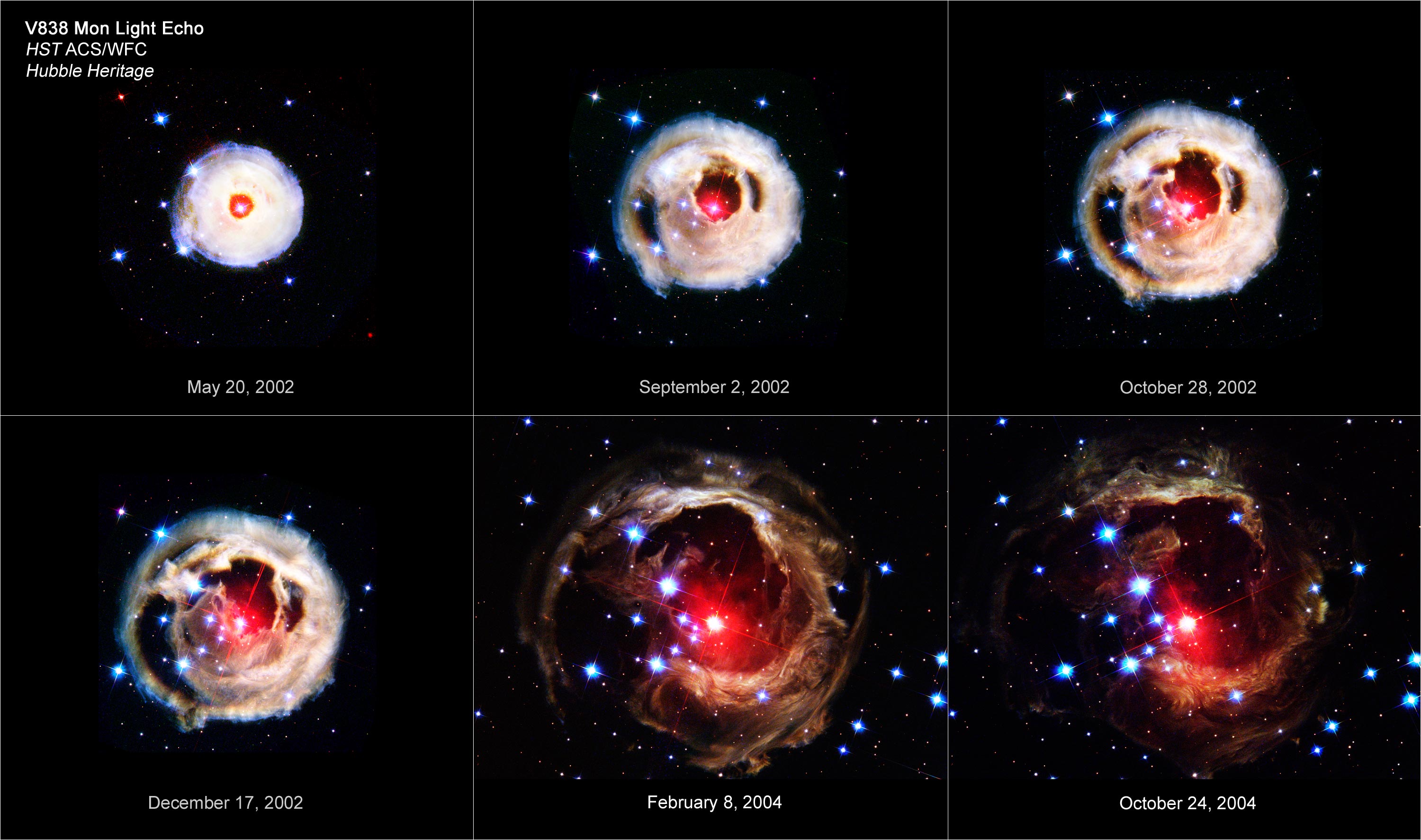V838 Monocerotis
Constellation: Monoceros
Spectral class: M6.3
Coordinates: 07h 04m 04.85s (right ascension), -03°50’50.1” (declination)
Visual magnitude: 15.74
Distance: 20,000 light years (6,100 parsecs)
Radius: 380 solar radii
Temperature: 3,270 K
Luminosity: 15,000 solar luminosities
Designations: V838 Monocerotis, V838 Mon, Nova Monocerotis 2002, GSC 04822-00039
The distance to V838 Monocerotis was initially estimated to be 1,900 to 2,900 light years as a result of an incorrect interpretation of the light echo the outburst generated. Taking into account the star’s visual magnitude before the eruption, astronomers assumed that V838 Mon was an F-type dwarf, similar to the Sun. However, the star is significantly more massive and luminous than the Sun, and more accurate measurements using a technique based on the polarisation of the reflected light resulted in an estimated distance of 20,000 light years from Earth. In 2005, a team of scientists suggested that the star was a supergiant with a mass about 65 times that of the Sun and an estimated age of only 4 million years.
Tim Thompson Monocerotis
The Young Cluster and Star Forming Region NGC 2264

S MON (S MONOCEROTIS) = 15 MON (15 MONOCEROTIS). S Mon is a barely-fifth magnitude (nominally 4.66) blue- white class O (O7) dwarf in the constellation Monoceros. It is slightly variable by several hundredths of a magnitude, hence the variable star name, “S.” The setting is glorious. S = 15 Mon falls among the stars of the young cluster NGC 2264, is surrounded by a bright nebula called Sharpless 273, which it helps excite, and lies to the north of one of the fantastic sights of the sky, the “Cone Nebula,” a long dark interstellar dust cloud that is being evaporated at its tip by another nearby hot star. All of this picture is associated with the Monoceros OB1 association of massive stars and a huge, dark star-forming molecular cloud. The primary problem is S Mon’s distance. Direct parallax gives 1000 light years. However, at that distance, the star is notably underluminous for its class. Most likely, S Mon is a member of the cluster, which has a rather firm distance measure (from the brightnesses and temperatures of its stars in comparison with nearby clusters) of 2500 light years, 2.5 times as far. At that distance, adopting a temperature of 37,500 Kelvin and allowing for 0.2 magnitudes of absorption by interstellar dust, S Mon comes in at a luminosity of 217,000 Suns and a whopping 35 solar masses. The problem here is that the star is not single, but binary, consisting of two hot stars in a 25-year orbit. Observation of the orbit through interferometry and with the Hubble Space Telescope gives a mean separation of 26 Astronomical Units (AU), an eccentricity that takes them between 46 and 6 AU apart (for a distance of 2500 light years), and masses of 18 and 12 times that of the Sun.

The brilliant, very young O dwarf 15 = S Monocerotis consists of two stars in a tight 26-year, quite eccentric, orbit. The axes are in seconds of arc. North is to the bottom, as is traditional. The filled and open circles are actual observations and predicted positions. The dashed curve is an older calculated orbit, while the solid one is a revised orbit. The large gray circles do NOT represent the primary star, but are resolution limits (the degree to which the system can be seen in detail) for the instruments that made the observations. On this scale, the stars would be mere dots. (From an article by D. R. Gies et al. in the Astrophysical Journal, vol. 475, p. L49, 1997.)
One or both are rotating rather quickly, at least 63 kilometers per second. Given that the cluster and S Mon are very young (various populations of the cluster ranging from under 1 to 10 million years), from theory and these masses we derive an apparent magnitude of 5.6, nearly a full magnitude (a factor of 2.5) too faint. Higher masses could do the job, but these are out of line with the combination of orbital solution and cluster distance. Whatever the resolution of the problems, though, it is clear that we are dealing with a massive pair of stars (perhaps 30 and 20 solar) with luminosities the order of 125,000 and 50,000 solar, both of which could, and probably will, explode as supernovae. As they evolve, they will probably also interact with each other. As it is, at least one of them is blowing a strong wind with a mass loss rate of about a millionth of a solar mass per year. The action is “watched” by a small host of companions, three class B and A stars out to 40 seconds of arc (30,000 AU) away. Stay tuned over the years for additional research, as examination of such stars is profoundly important to the study of star formation and evolution. Thanks to Bas Verhagen, who suggested this star.


- How the NYT Frames it : Sept. 3, 2014
The V838 Monocerotis Star Still Has Astronomers’ Heads Exploding
For astronomers and aficionados of cosmic violence, an obscure star known as V838 Monocerotis has turned out to be a gift that has kept on giving for a long, long time.
The star forms part of the shoulder of an imagined unicorn in the constellation Monoceros, 20,000 light-years away, and in January 2002, astronomers saw it blow up. Over the next few months, it became a million times as luminous as the sun and swelled in diameter to a billion miles, comparable to the orbit of Jupiter. It was briefly one of the most luminous stars in the galaxy.
Some scientists have suggested that V 838 swallowed planets in its orbit. Others have proposed that V 838 was actually two stars orbiting each other, and that the explosions were a result of their atmospheres merging into a common envelope of gas.
Astronomers are still arguing and speculating about what happened. Measurements of the star’s light output showed that the explosion happened in three stages, flaring and then dimming three times from January to March 2002.
The answer could be relevant to our plight. Someday, a few billion years from now, the sun will run out of fuel and become a red giant,swallowing Mercury and frying the Earth and Venus.
Whatever it was that made V 838 erupt, astronomers are still watching it go.
The star, it turns out, is embedded in a cloud of dust trillions of miles across. Most likely, astronomers say, these wreaths of dust gave rise to V 838 perhaps four million years ago. They would usually be invisible, but the pulses of light traveling outward from the explosion have illuminated shells of dust previously kicked off the star. The Hubble Space Telescope has recorded images of these so-called light echoes, and viewing them in succession calls to mind the explosion of Darth Vader’s Death Star — except that in this case, nothing is moving but the outward-rushing light wave; the dust is standing still.
As a result, the death of V 838 Monocerotis is giving astronomers a rare look at the circumstances that gave it birth. Dust to dust and ashes to ashes. So it goes.
Nothing lasts forever, but in the universe, nothing is ever really gone, either. As the Columbia University astrophysicist Caleb Scharf pointed out in an essay on his blog recently, long after you and I are dead, the light reflected off our faces today will still be traveling across space, ever fainter with distance, but always there. For somebody with a big enough telescope somewhere, we will be immortal.



